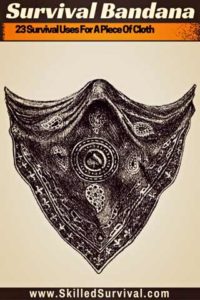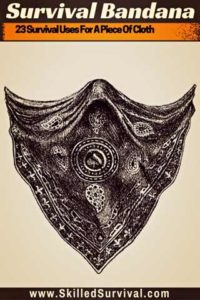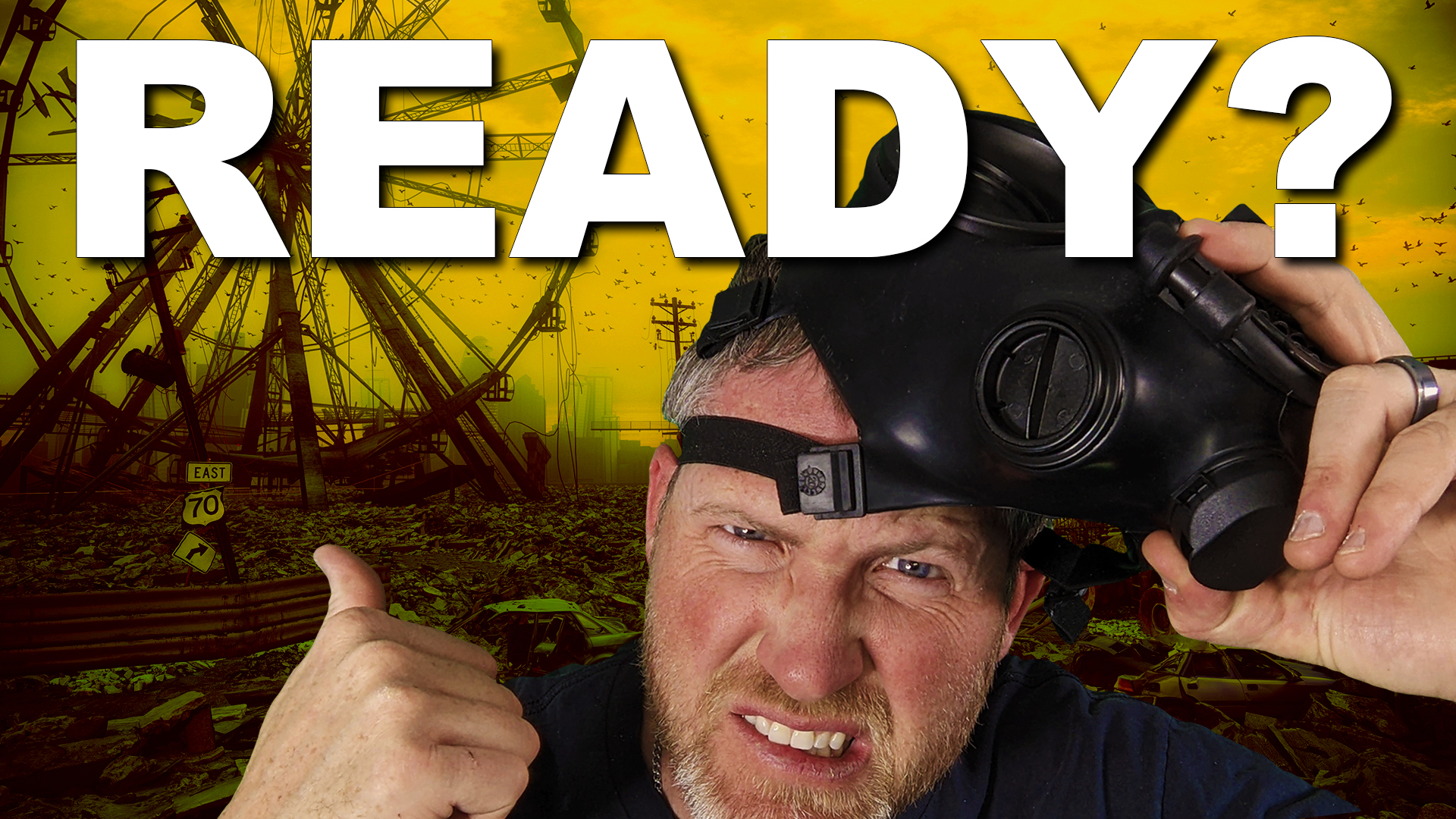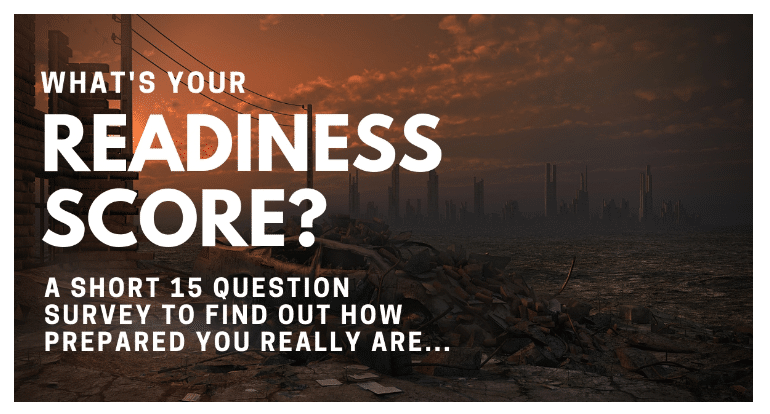
For most, yes, but if you’re a survivalist you understand how a single piece of cloth can be an extremely valuable resource.
A Survival bandana is any bandana put to good survival use.
A survival bandana is a tool just like any other survival tool.
Many are made with durable materials, while others include survival knowledge on them.
That’s why you should spend a couple of bucks to add one to your survival gear.
So today I’m going to share with you, my favorite survival uses for a bandana.
Survival Bandana: 40 Uses
Are You Ready For The Tough Times Ahead? Take My 60 Sec Quiz To See If You’re Part Of ‘The Fragile Masses’ Or Not… Start Quiz Now!
23 Survival Uses For Your Bandana
1. Signaling For Rescue
Sure, that camouflage pattern bandana looks badass and blends in perfectly from a distance. But let’s be honest, a bandana isn’t going to make you invisible, but it can do exactly the opposite.
Let’s say you’re out hunting and break your legs while you’re decked out in full camo – wouldn’t it be more helpful to reach into your pack and grab a couple of bright neon bandanas and make a flag or hang them around you?
Just like with signal mirrors, search and rescue teams across the country recommend using a bright bandana to signal to a search aviation crew because they stick out from natural colors.
More than that, if you need to signal to someone else without speaking or making noise, different brightly colored bandanas can be used to communicate with one another over distances.
101 Uses of a Bandana – Survival, Medical, Tactical, Humor
2. Establishing Trail Markers
Sick of getting lost when you go bushwhacking in the wilderness? Lots of hunters, hikers, and other explorers use neon plastic tape to tie to tree branches and mark their way home.
Like Hansel and Gretel; only no one is going to come around eating plastic stuck in trees so that you won’t get lost.
Likewise, brightly colored survival bandanas can be torn into ribbons and tied to trees to mark progress and keep your bearings straight. Don’t be afraid to tear that bandana up into several trail marker ribbons. It’s a large part of its usefulness, and they are easy to replace.
If your bandana is sentimental, leave it at home and instead invest in a cheap new one to add to your survival gear.
3. Dirty Dish Rag
I love to cook when camping. I have a nice setup of camp cookware that I take with me everywhere.
But when I’m out and away from sinks and sponges, sometimes washing dirty dishes can be a serious pain.
In a pinch, bandanas can be soaped up and used as dish rags to get in there and clean up.
4. Napkin/Handkerchief
I don’t know that this one needs a lot of explanation. If you sneeze or have allergies, wipe that nose with your bandana and clean yourself up.
If you don’t have proper paper napkins or paper towels laying around, use your bandana. Either way, make sure you rinse it out when you’re done.
5. Neck Gaiter for Cold Weather
Winter is without a doubt, my favorite season. Why? Because it’s ski season, snowshoe season, igloo season, and the season of big warm jackets and crisp silent nights.
But everyone’s face can get cold in that kind of weather, and even a very thin layer of cloth can make a BIG difference.
So if you’ve got a survival bandana handy and the cold weather is biting at your face, cover up like a bandit and use it as a neck gaiter. You’ll be surprised at how efficiently this works to keep the cold at bay.
So if you’ve got a bandana handy and the cold weather is biting at your face, cover up like a bandit and use it as a neck gaiter.
You’ll be surprised at how efficiently this works to keep the cold at bay.
6. Makeshift Tourniquet
No one expects to amputate a limb when you leave the house in the morning, but you can never be entirely sure.
Should the need for a tourniquet arise, bandanas can cinch really tightly in a pinch and will do an OK job in lieu of an actual rapid application tourniquet. (But for snake bites use a Sawyer Extractor, this will work much more efficiently to prevent the venom from spreading)
7. Cordage
As I mentioned earlier: never hesitate to tear your survival bandana up to increase its usefulness. Often, bandanas are more useful in pieces than they are wholly intact.
If you need to bind a broken bone to a splint, bind tent poles together, bind something to your pack, bind a person’s hands, bind an animal, whatever!
Bandanas can do the job. The fabric makes for decently strong cordage.
I’d rather have paracord with me as cordage but a bandana works too if push comes to shove.
8. Washcloth or Towe
If I forget something when I pack my backpacking backpack, it is a washcloth and a towel. I will ALWAYS remember everything else, but never that.
The problem got so bad that I have just resorted to using bandanas.
They are smaller, easier to pack, and much easier to remember to bring (for me at least). So you can’t wrap it around your waist to cover yourself after bathing.
But who doesn’t love a little nudity in the wilderness? You may be naked but at least you’ll be dry.
As A Way To Introduce You To Skilled Survival, We’re Giving Away Our Ultimate Survival Gear Checklist. Click Here To Get Your FREE Copy Of It.
9. Waist pack/pouch
If you tie the right knots in the right places, you can fashion a small waist pack for yourself. Like a homemade fanny pack to keep your favorite goodies close.
I’d rather have a tactical molle pouch for survival but I’m assuming you’re having to improvise.
This works in the wilderness for recreation or for survival. It could even come in handy at the next music festival you go to sneak goodies inside (but you didn’t get that idea from me).
10. Pot Holder
Hot stuff burns hands. That’s science. So protect your grabbers with a survival bandana next time you reach for that hot pot in the fire. I
can’t promise you that it will mitigate all of the heat, but it will help.
11. Pouch for Collecting Wild Edibles and Ingredients
Now, don’t go out picking berries, mushrooms, and roots without at least a basic understanding of what you are picking.
It can be extremely dangerous to eat whatever you come across in the wilderness, but it can also be highly useful if you have the right wild edible knowledge base.
Get the book “From Dirt To Plate” on foraging if you’re seriously interested.
Needless to say, once you know what you are doing, bandanas can be used as containers to collect such edibles from your surrounding area, and transport them back to your home base or bug out location.
12. Sunblock
When I was traveling in Asia I would often tuck one end of my bandanas underneath my hat. This served two purposes: first, to keep the sun from burning the crap out of my pasty white skin.
And second, to keep sweat contained, and prevent it from evaporating off of my pasty white skin.
When you’re in intense heat like that, the last thing you want to do is take off your clothes and let your sweat disappear into the scorching air.
It is better to use cotton garments to keep as much moisture as close to the skin as possible – so that means, leave the t-shirt on and use that bandana to save your sweat!
13. Sling
Luckily, when we crashed our bikes there were no broken bones. But if there had been, a bandana would have been the perfect fabric to make a sling out of.
Slings keep injured body parts close to the body and elevated to minimize swelling.
Anyone who has ever needed to use one knows that they help SO MUCH when you’ve got an injured arm/shoulder.
Doctors and first responders always carry triangle bandages in their medical kits to create slings on the fly – but homemade med kits might not have any of those.
In the absence of a real sling or triangle bandages, bandanas can be substituted to hold injured limbs aloft – although they are slightly smaller than regular triangle bandages.
14. Sling
Yeah, you read that right, I put “slings” on here twice. That’s not a typo – I mean to say that you can make two different kinds of slings out of the same single survival bandana.
The first was discussed above; the second is the kind that David used to defeat Goliath, the kind that our ancestors from long ago used to hunt animals, and fire projectiles at their enemies with.
Look up a simple DIY on how to make a sling and you’ll be able to see how you can use a bandana to achieve a similar effect.
This can come in useful for hunting small animals when you have no other source of food, or for defending yourself when you have no other means of doing so.
15. Eyepatch
Losing an eye would suck. My condolences to anyone out there who’s suffered such a serious inconvenience.
But stuff happens, and if you were to lose an eye in a survival situation, you probably aren’t going to be able to get to a hospital to bandage yourself up.
Without covering the wound, it could get infected much more easily and will be exposed to the elements and unwanted guests (like the bugs that tried to infest my road-burn wounds).
16. Pre-water Filter
Do you know how coffee filters work? Well, bandanas can achieve a similar function to water.
By using a piece of mildly tight-knit fabric (like the cotton of a bandana) to filter water in the wilderness, you can significantly cut down on debris and unwanted waterborne guests.
This won’t replace your pump-action water filter, or iodine tablets (by ANY means) but if it is the only method you have available for filtering water, definitely use it. While it won’t protect you from every waterborne nasty, it will protect you from some of them.
17. Hobo Pack
This one’s a Great Depression Era classic.
Find yourself a stick, tie the corners of your survival bandana together on one end of it, and voila! You have yourself a handy little shoulder pack.
Granted, it isn’t great for holding tons of stuff. But it can take the weight out of your pockets at the very least and allow any traveler a little extra packing space.
18. Cleaning Patches for Firearm
Every gun owner knows that keeping a survival firearm clean is imperative if you want to rely on and trust in your firearm.
But you never know when and where you might have to use your gun – if you need some cleaning patches to polish up your weapon. Bandanas can work as a basic substitute for a gun cleaning kit.
Just tear it up into small pieces and gently dab some gun-cleaning oil on them, then get to it!
19. Bullet Patches for Muzzleloader
If for whatever reason, you’re stranded, and you have a muzzleloader with you, bandanas can also serve as decent bullet patches to keep the bullet and gunpowder separate.
20. Toilet Paper
Need I say more?
21. Earmuffs
They won’t be the warmest earmuffs on the market, but if your ears are exceptionally chilly, wrap your bandana around your head and cinch it tightly. I
t’s no replacement for a wool cap or fleece muffs, but it is certainly better than nothing.
A survival bandana may be just enough to save your ears from frostbite.
22. Bind A Stone and Toss A Line Over A Limb
Let’s say you need to throw a line over a tree branch or steel beam.
Tying a cord or line to a stone can be a difficult endeavor. But if you wrap the stone up in your bandana, and tie the line to that, you have a much more efficient tool and a much lower chance of failure.
23. Dust Mask
I always think of that scene from “Fear and Loathing in Las Vegas” when Thompson’s out in the desert following dirt bikes around in a buggy, dust so thick in the air that visibility is negligible.
Breathing in heavy amounts of dust or soot or smoke can be unimaginably stressful on human lungs.
Especially if you have to inhale that crap for an extended period of time. Of course, a gas mask or respirator is almost always the best option in such a circumstance. But those are rarely available.
Tying a survival bandana around your face can help filter out a significant amount of air pollution and will save your lungs. Even that thin layer of cotton can go a long way when it comes to breathing in toxic air.
As A Way To Introduce You To Skilled Survival, We’re Giving Away Our Ultimate Survival Gear Checklist. Click Here To Get Your FREE Copy Of It.
Survival Bandana Wrap Up
Obviously, these aren’t all of the potential uses for a survival bandana, but a few of the obvious ones, and some of my favorite creative uses.
You can surely think of a few more, and in an emergency, under pressure, who knows what kind of crazy ends you’ll use your bandanas to achieve.
If I hadn’t taken a survival bandana when I was traveling, I could have gotten an infection, severe skin damage, or worse – baby flies popping out of my skin.
But because I was prepared, and because I understood the versatility of the survival bandana, I was able to save myself from those horrors.
Finally here’s a good video that details 101 survival uses for a bandana. From bushcraft to medical, from tactical to humor; this video covers them all.
If you have any more survival bandana ideas or stories, feel free to share them. People need to understand how easy these are to keep around, and how helpful they can be in a dangerous situation.
Will Brendza
P.s. Are you ready for the tough times ahead?
Find out now by taking my short Readiness Score Quiz – it’s absolutely free.
Once complete, you’ll know exactly where you stand on the “fragile” vs.” resilient” spectrum.
So click here to start the Quiz….And don’t worry; the questions are so easy a 3rd grader could answer them.
Click on the image to begin the Quiz and find out once and for all if you’re part of “The Fragile Masses” or “The Resilient Few.”
Header Image Source
The post How To Use A Survival Bandana To Save Your Life appeared first on Skilled Survival.




